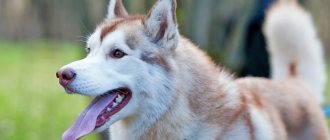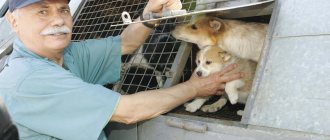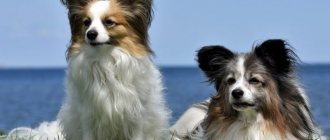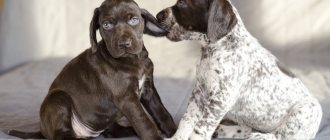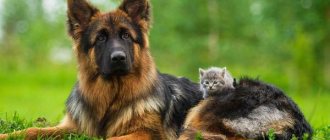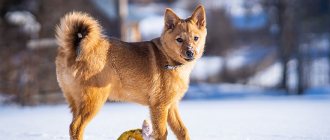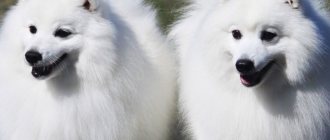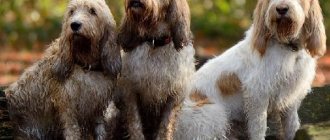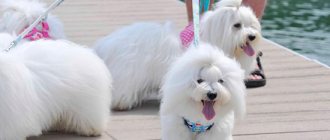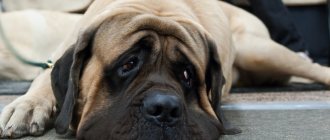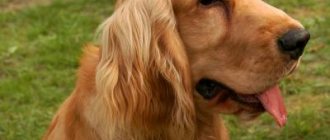Breed varieties
Husky is a common name for sled dogs from different regions. Depending on the territory of origin, the following types of huskies are distinguished:
- Alaskan Husky. It is related to Sheepdogs, Malamutes and Border Collies. These are short-haired huskies that feel great even in the harshest weather. Very affectionate, sweet and devoted creatures. They get along well with small children.
- Klee-kai. American mini version, released in the States in the 70s. XX century An adult Klee Kai Husky grows up to 40 centimeters at the withers and weighs no more than 7 kilograms. An active, smart and cheerful dog. Despite its small size, it has good health and lives up to 16 years.
- Siberian Husky. One of the oldest indigenous breeds. Bred by the Chukchi as a sled dog. They grow up to 50-60 centimeters, very hardy. Not suitable for hunting.
- Sakhalin Husky. Powerful and hardy dog. Can reach up to 70 centimeters at the withers. A distinctive feature is the lush “collar” in the neck area. This is the longest-haired husky among all representatives of the breed. He loves people and has a calm disposition. However, it is least common as a pet.
This is interesting! The Sakhalin Husky is sometimes called the Sakhalin Laika.
Are Husky dogs suitable for living in an apartment?
Husky puppies quickly adapt to apartment conditions. The main thing is to provide them with proper physical activity. Without it, the pet can turn into a destroyer. After all, it is also a hunting dog.
However, a long walk and a sufficient number of games do not at all guarantee that the furry baby will behave docilely. A puppy is a puppy, and therefore he can chew everything he can get his teeth into, or play, turning the house upside down.
Another point is molting. During this period, dogs lose a lot of hair. If you comb them irregularly or do it poorly, the floors and furniture in the apartment will become downy.
Husky puppies: how to prepare your home for new residents
Before the puppy arrives, you must purchase:
Important! The dog should be able to stand up to its full height in the crate, and also stretch out to its full length if desired.
Baby husky in a private house
An undeniable advantage of the Husky breed is its frost resistance. For an adult dog to winter in the yard, an enclosure with an insulated kennel is sufficient, but a puppy must still winter in the house for the first six months.
It is worth accustoming to the enclosure gradually, bring the puppy there during the day and for a short time, play with him in the enclosure, you can lock him in it if at that moment you are in the puppy’s field of view. Let your child understand that the enclosure is his home, and not a punishment, that he is not abandoned in it. Put toys there, put a bowl, let the puppy be comfortable and not bored.
Build the enclosure itself with a sufficient area, the dog should be free in it and not experience the feeling of a cage. The walls of the enclosure are made to be at least two meters high, and the foundation around the perimeter is reinforced with a metal mesh to prevent digging. Even husky puppies love to do this, because in their natural habitat they dig holes for themselves to sleep in the snow.
In the summer, a puppy can be accustomed to an enclosure almost immediately, especially if he has the full set of “outdoor” vaccinations. Provide a shaded area so the dog can hide there from the summer heat.
Is it possible to keep a husky outside?
This breed is comfortable outdoors. She won’t get bored, because there are a lot of things to do in the open space. Also, don't worry if your dog prefers to sleep in the snow during the winter. This is her northern blood speaking.
But your pet definitely needs to be protected from the sun, so you will need to build a canopy over the dog kennel.
This is interesting! Huskies love to climb, so it is advisable to make the roof of the kennel flat so that the dog can climb on it.
Husky dog enclosure
When building an enclosure, it is important to consider a number of points:
Diseases and vaccinations
Dogs of this breed are characterized by very good health, but this does not mean that they are not susceptible to diseases, including infectious ones.
At the age of 2 months, dogs are given a combined vaccination against rabies, distemper and enteritis, with a second dose administered a month later. To prepare for vaccination as planned, the puppy should be given anthelmintic drugs 10 days before. After the second vaccination, the dog stays at home for two weeks, and then it can be taken outside. After a year, it will be necessary to revaccinate in the same way.
During the warm season, it is important to protect dogs from ticks, as they are carriers of piroplasmosis, which can potentially be fatal to a pet. To protect your dog, you can use prophylactic collars or pharmacological external agents, as well as preparations for internal use.
Most often in Husky dogs, the eyes, ears, musculoskeletal system and nervous system are affected, and with improper nutrition, internal organs, especially the gastrointestinal tract. Therefore, it is necessary to monitor the appearance, walking and training, as well as the nutrition of your pet, then it will be strong and healthy.
To learn how to care for a husky, watch the following video.
How to choose the right husky puppy
Finding the right puppy for this breed is quite difficult. Babies can change a lot as they get older. Therefore, an experienced breeder can help in choosing.
The main thing is that the future owner decides for what purpose he is purchasing a dog: he wants a faithful friend or a show dog.
What age can you buy a puppy?
Usually puppies are given away at two months of age. However, it is worth buying such a baby only if the future owner wants to buy a friend and companion.
Important! To make sure that the characters match, it is useful to periodically visit the puppy you like and spend time with him.
If a Husky is purchased for exhibitions or breeding, the most suitable time is 8 weeks of age. From this period it is already possible to understand what an adult dog will look like: assess the proportions, head size, correct bite and position of the paws and tail.
Of course, it’s impossible to give a clear assessment, but at this age the likelihood of finding a future champion is much higher.
How to choose a good breeder
In fact, the specialist chooses the owner for the puppy, and not vice versa. A responsible breeder will conduct an entire “interview” to understand whether the person can provide quality care for the baby.
And if it seems to him that the potential owner does not understand the specifics of the breed or will not care for the puppy as necessary, the deal will most likely not take place.
The breeder himself will not refuse to visit the nursery so that the person can see the conditions in which the puppies are kept and also get to know their parents.
Important! The mother of newborn puppies will not look her best. The body needs time to recover. Therefore, you should not judge by her appearance the integrity of the breeder or how the puppies will grow up.
When handing over the puppy, the breeder will talk about care, enter into a purchase and sale agreement, and also issue a pedigree, registration with the RKF and a veterinary passport, which contains all the information about vaccinations and anthelmintic procedures.
What to look for when choosing a puppy
First of all, it is worth looking at the entire litter to assess how the puppies interact with each other:
It is also important to evaluate the appearance of the puppies. They should be well-fed, with clear eyes and a shiny coat.
How to determine the pedigree of a puppy
Huskies are harmoniously built, muscular dogs. The breed standard defines the following data:
All these qualities are visible in puppies from an early age.
The choice of carousing depending on gender
The gender of the dog primarily affects behavioral qualities.
A husky boy is stronger and more resilient. He is calm and requires less attention. However, it is more difficult to raise him, since the natural aggression of males can make itself felt.
Female huskies are easier to train because they do not have such aggression and are unlikely to dominate the pack. But they are weaker than males. It is also worth considering that they lose their working qualities during periods of estrus.
Dog character
The Husky dog is active, smart and independent. In its veins flows the blood not only of ancient sled dogs from the far north, but also of wolves, therefore the habits of this proud wild beast remain in the character of the breed. The blue-eyed husky quickly learns a variety of complex skills. He is used to making decisions on his own. In their natural habitat, such dogs often get their own food, which is why they have highly developed hunting instincts. The breed cannot be called noisy. The Husky has an unusual voice; these dogs sing rather than bark.
The husky's character is balanced, friendly, with pronounced leadership qualities. This breed will not make a home guard: it treats people too well, has a very good-natured disposition, and rarely bites. But the dog will become an excellent friend for the child: the dog will never offend the baby, she is always ready to play with him. Huskies can be stubborn and cunning, they are excellent at covering up the traces of their dirty tricks, and begging for treats even when they are not deserved. If the puppy is not shown in time who the real leader is, he can become dominant in the family, then it will be difficult to cope with an active dog.
The Husky is a pack dog, because in its homeland it carried loads in a group harness, and therefore gets along well with other dogs. Many owners have 2 or even 3 huskies in the house at the same time. A dog can also get along with cats, but only if he grows up with them from early childhood. But rodents and birds will become prey for him, so it is not recommended to have a husky in a house where rabbits, parrots or small hamsters live. But children will become best friends for this breed, and contact will quickly develop between them. Dogs are good as nannies for children and playmates for teenagers.
Keeping a Husky puppy
This is one of the most unpretentious breeds. However, caring for a puppy has certain subtleties. After all, it is from an early period that the dog’s health and character are established.
Diet for the Husky breed
You should select food specifically designed for active dogs. They contain more proteins and polyunsaturated fatty acids, which is important for energetic huskies. You should not buy mixtures containing starch. This breed does not digest them very well.
For small puppies, food should be steamed in boiled water or warm broth. Older babies can be switched to solid food.
When keeping natural food, it is important not to upset the balance. The puppy's diet should include:
- raw (or scalded) meat (beef, rabbit, turkey). It is better to avoid chicken, as it can provoke allergic reactions;
- boiled sea fish (the most natural food for a husky);
- boiled eggs (yolks can be given raw);
- dairy products (only for puppies; adult huskies are best switched to fermented milk);
- buckwheat, oats, rice;
- raw or boiled vegetables, herbs (except beans and potatoes);
- fish oil and vegetable oils (drop into porridge).
Important! Dogs that eat natural foods should be given vitamins and minerals. However, it is better to consult a veterinarian before using them.
Huskies burn more calories in winter. Therefore, the serving size needs to be increased. However, this applies primarily to older puppies, which can already be left in an outdoor enclosure for some time.
Feeding husky puppies by month
A one-month-old puppy should be given more formula milk, as well as meat, which is ground to a mushy consistency. For vegetables, you can offer carrots.
The diet of a husky at 2 months is made more varied by increasing the content of vegetables: onions, cabbage, beets and herbs. Everything is served stewed.
At 3 months old, a husky gradually becomes accustomed to fish. It is better to give preference to sea, which must first be frozen. Three-month-old husky puppies can also be given river fish, but it should be served boiled and without seeds.
At 4 months, porridge with butter and vegetables, as well as fermented milk products, are added to the Husky’s diet. In addition, you can give eggs (preferably quail and infrequently, about 1-2 times a week).
A husky at 5 months can be given the same as an adult dog. The difference lies in the amount of food received. If an adult dog eats 1-2 times a day, then a puppy eats 3-4 times. The portion should weigh 2 percent of the animal's weight.
At 6 months, a husky is switched to three meals a day (some owners prefer to do this at the age of 7 months).
Puppy ageFeeding frequency
| 1 month | 6 times a day |
| 2-3 months | 5 times a day |
| 3-4 months | 4 times a day |
| 4-6 months | 3-4 times a day |
| 6-10 months | 3 times a day |
| from 11 months | 2 times a day |
Raising a Husky puppy
Husky is a self-sufficient breed. And this manifests itself from a very early age. Therefore, you should start training your puppy as early as possible, otherwise you may miss the moment and end up with a spoiled and disobedient dog.
Initially, it is worth teaching the puppy basic commands. And from the age of six months you can go to a dog handler.
The peculiarity of the breed is that huskies are able to learn from their brothers. Therefore, being around a well-bred and well-trained dog will have a positive effect.
Basic principles of training a puppy:
How to train a puppy to use the house toilet
Diaper (or newspaper) training is a fairly simple process. Monitor your baby's behavior. As soon as he starts fussing and looking for a place to eliminate, take him to the diaper, hold him in place and praise him constantly.
Usually puppies want to go to the toilet after they have slept or eaten.
How to train a puppy to toilet outside
As soon as the baby is fully vaccinated, he can be taught to go to the toilet outside. This is also not difficult, since cleanliness is a feature of the breed. When the puppy is ready to go to the diaper, take it outside. As soon as the dog gets used to the new regime, remove the “toilet” altogether.
Leash training
First of all, you should explain to the puppy that the leash is not just another toy. You should immediately give a prohibiting command if the baby starts gnawing on the ammunition.
You need to start walking your puppy on a leash for a few minutes a day at home. When the dog gets used to it, you can go out into the yard, and then calmly walk on the street.
Walks and exercise for the Husky breed
Since this is a very energetic breed, walking should be at least 2-3 hours a day. Moreover, a conventional study of the area may not be enough.
It is worth taking the puppy to sledding classes so that he can see and get used to what is happening. And when he grows up and gets stronger, he will be able to take part in competitions himself.
Typically, huskies pull sleds, skiers, roller skaters, cyclists and even charioteers.
When walking in the warm months, it is worth taking a sufficient amount of water. Your pet will definitely want to drink. In addition, it will not be superfluous to wet his thick fur coat so that he does not suffer from the heat.
Important! It is necessary to take into account the husky's natural tendency to escape and chase prey. It is better not to let your pet off the leash if there are other animals nearby.
Husky health
This is a healthy and hardy breed. However, your dog may have the following diseases:
- dermatitis;
- benign and malignant tumors;
- increased blood pressure;
- paralysis;
- eye problems (retinal dystrophy, cataracts, glaucoma, entropion).
Hygienic care
The dog does not require special care. This is a clean breed that takes care of its coat independently.
Only the molting period can cause some inconvenience. This happens 2 times a year. During this time, you need to constantly comb your pet.
Caring for your eyes and ears includes periodic examinations. And if necessary, clean with damp swabs.
Husky claws usually wear down on their own during intense walks. It is recommended to wash these dogs only when necessary. Usually once a year is enough.
Education and training
The owner of a husky puppy should know that this breed loves freedom very much, huskies often run away, so the command “Come to me!” should be fundamental from the first days.
The baby is called to you periodically in various conditions: at home, on a walk, during classes, and is always treated to a treat.
The puppy should willingly run when called, even while playing with other animals - this is an important element of training .
Well-trained Husky puppies make wonderful companions and close friends with children.
By fastening the puppy on a harness , it is easier to control him, so calling can also be practiced while walking around the city.
It is advisable for the husky to be calm about any irritants: city noise, cars, other animals, people - by changing walking routes, the owner quickly socializes the baby.
Classes at the training ground should be attended immediately after the end of quarantine, especially for show puppies.
Movement in a circle and learning to stand calmly in an exhibition position are easier to practice from an early age.
One of the characteristics of husky puppies is their piercing gaze.
If a husky lives in a house, constantly communicates with the owner and family members, and walks on a leash for at least two hours a day, then an unintelligent puppy will quickly grow into the smartest dog that understands everything.
The more time spent with a dog as it grows, the higher its intelligence.
Husky puppies: care, feeding, education
Adorable husky puppies leave no one indifferent, especially if their cute face and thick paws are accompanied by a piercing blue gaze. And although not all Siberian Husky puppies have blue eyes, it is this quality that attracts the most attention to them.

